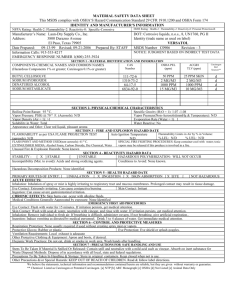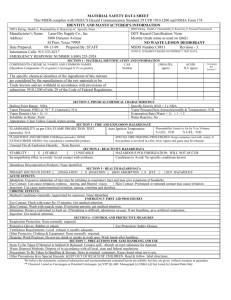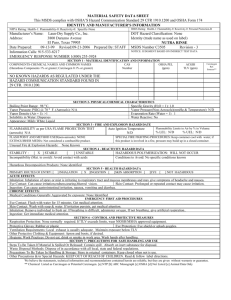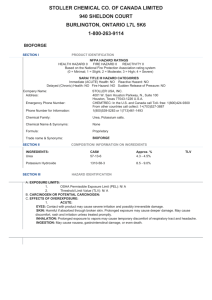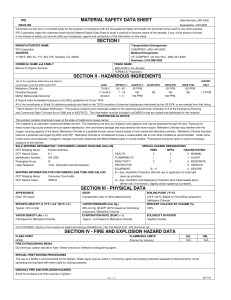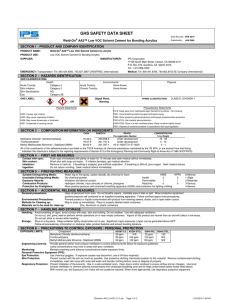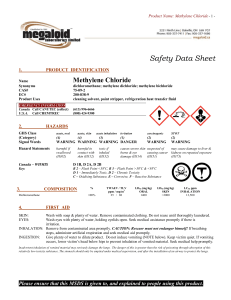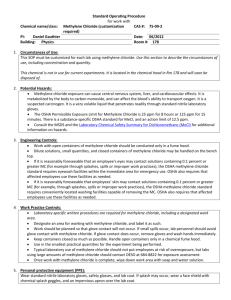Anti Spatter (Aerosol) MSDS () - Weld
advertisement
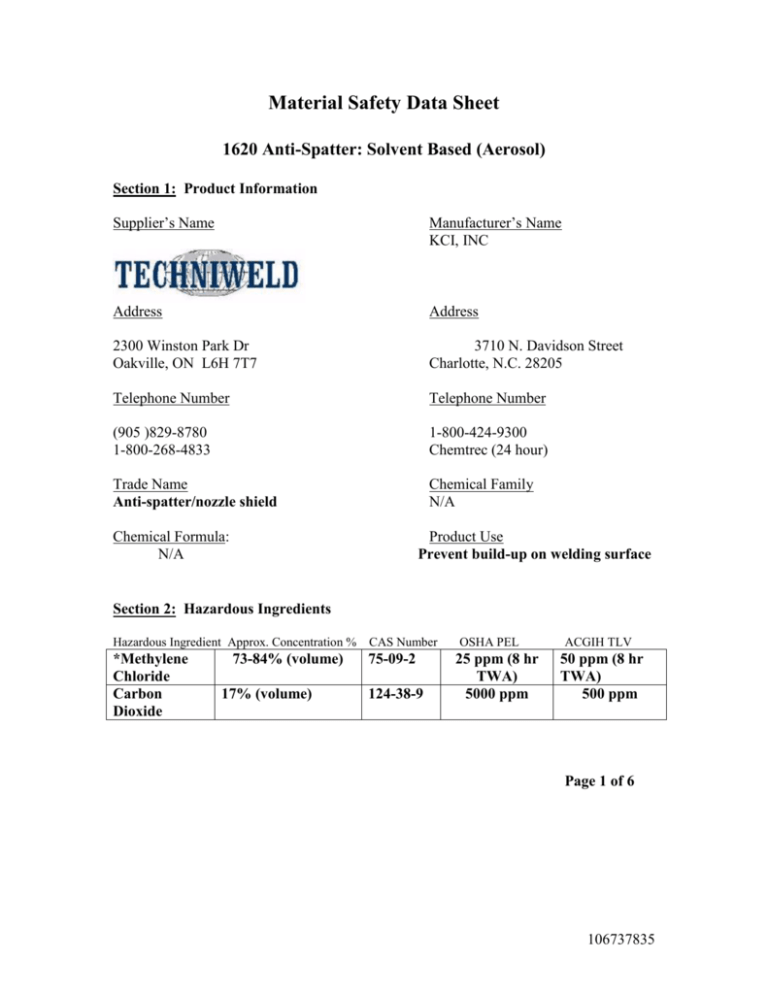
Material Safety Data Sheet 1620 Anti-Spatter: Solvent Based (Aerosol) Section 1: Product Information Supplier’s Name Manufacturer’s Name KCI, INC Address Address 2300 Winston Park Dr Oakville, ON L6H 7T7 3710 N. Davidson Street Charlotte, N.C. 28205 Telephone Number Telephone Number (905 )829-8780 1-800-268-4833 1-800-424-9300 Chemtrec (24 hour) Trade Name Anti-spatter/nozzle shield Chemical Family N/A Chemical Formula: N/A Product Use Prevent build-up on welding surface Section 2: Hazardous Ingredients Hazardous Ingredient Approx. Concentration % CAS Number *Methylene Chloride Carbon Dioxide 75-09-2 73-84% (volume) 17% (volume) 124-38-9 OSHA PEL 25 ppm (8 hr TWA) 5000 ppm ACGIH TLV 50 ppm (8 hr TWA) 500 ppm Page 1 of 6 106737835 Section 3: Physical Data Physical State: Liquid Odour and Appearance: Clear, colourless liquid. Chloroform –like odour Odour Threshold(PPM): 1000 Specific Gravity: 1.32 Vapour Pressure(MM) 390 (mmHG) Vapour Density (Air =1): 2.9 Evaporation Rate: 14.50 Boiling Point: 104ºF Freezing Point: N/A Solubility in Water(20ºC): 1.3 % Volatile (by Volume): N/A PH: N/A Coefficient of Water/Oil Distribution: N/A VOC Content: 93% Section 4: Fire or Explosion Hazard Flammable: No Means of Extinction: Carbon dioxide, dry chemical or foam Special Fire Fighting Procedures: Pressure demand, self-contained protection should be provided. Storage containers exposed to fire should be kept cool with water. Unusual Fire and Explosion Hazards: At high temperatures, over-pressurization of containers can result. Flashpoint: None to boiling Upper Flammable Limit (% by volume: N/A Lower Flammable Limit (% by volume): N/A Auto-ignition Temperature: N/A Explosion data-sensitivity to mechanical impact: N/A Explosion data-sensitivity to static discharge: N/A Section 5: Reactivity Data Chemical Stability: Yes Incompatiblity to other substances: Yes If so, which ones? Oxygen, nitrogen, peroxide, oxidizers, and reactive metals (i.e. aluminum, potassium, sodium, etc.) Reactivity under what conditions? Avoid high pressure in aluminum systems, open flames and electrical arcs. Hazardous decomposition or byproducts: Combustion may yield CO, CO2, phosgene and/or HCl. Page 2 of 6 106737835 Section 6: Toxicological Properties Route of Entry: Skin: Eye Contact: Inhalation Acute: Inhalation Chronic Ingestion: Yes Yes Yes Yes Yes Effects of acute and chronic exposure to the material: Inhalation: In confined or poorly ventilated areas, vapors can readily accumulate and cause unconsciousness and death. Minimal anesthetic or narcotic effects may be seen in 500-1000ppm range. Progressively higher levels over 1000ppm can cause dizziness, drunkenness, concentrations as low as 1000ppm can cause unconsciousness and death. These high levels may also cause cardiac arrhythmias. Excessive exposure may cause irritation to upper respiratory tract. Excessive exposure may cause carboxyhemoglobinemia. Carcinogen city: Yes-NTP Yes-IARC MONOGRAPHS No-OSHA REGULATED Signs and Symptoms of Exposure: Light-headedness and nausea. Irritating to the eyes and skin. Medical Conditions Generally Aggravated by Exposure: Prolonged contact with high concentrations can lead to serious kidney and liver damage. Mutagenicity: Negative or equivocal results have been obtained in mutagenicity tests using mammalian cells or animals. This is consistent with the lack of interaction with DNA in rats and hamsters. Although results of AMES Bacterial Tests have generally been positive, overall the data suggest that genotoxic potential does not appear to be a significant factor in the toxicity of methylene chloride. Exposure Limits See above Irritancy of Material N/A Sensitization to Material N/A Reproductive Toxicity Teratogenicity Mutagenicity Carcinogen Toxicologically synergistic products Methylene Chloride is a suspected human carcinogen by ACGIH and IARC N/A N/A *see above N/A Page 3 of 6 106737835 Section 7: Preventive Measures Personal Protective Equipment: Polyfluorinated polyethylene gloves suggested Face shield and goggles should be worn No respiratory protection required during normal use Engineering Controls: Local exhaust use sufficient to maintain TLV Leak or spill procedure: Spills should be soaked up with absorbent. Area should then be flushed with water. All rinsate should be containerized and labeled. Spills on areas that are not on pavement can be handled by removing the affected soils. Handling procedures and equipment: Aluminum equipment should not be used for storage and/or transfer. Methylene chloride is not recommended for use near welding operations, open flames or hot surfaces. Waste Disposal: Material resulting from clean-up operations may be hazardous wastes and therefore subject to local, provincial and federal regulations. Storage Requirements: Use and store this material in cool, dry, well-ventilated areas away from heat and all sources of ignition. Keep containers closed. Keep away from incompatible materials (see Section 5). Do not enter confined spaces such as tanks or pits without following proper entry procedures such as ASTM D-4276. The use of respiratory protection is advised when concentrations exceed the established exposure limits. Wash thoroughly after handling. Do not wear contaminated clothing or shoes. Use good personal hygiene practices. Empty containers contain residue and can be dangerous. All containers should be disposed of in an environmentally safe manner and in accordance with all governmental regulations. Note: Aluminum equipment should not be used for storage and/or transfer of chlorinates. Special shipping Information: N/A Page 4 of 6 106737835 Section 8: First Aid Measures Eyes: Flush with water for 15 minutes Skin: Wash area with soap and water Ingestion: Drink water. DO NOT INDUCE VOMITING Inhalation: Remove to fresh air. If breathing has stopped, start CPR. Section 9: Preparation Information Prepared by: Techniweld Products Corporation (905) 829-8780 1-800-268-4833 Date Prepared: January 1, 2015 ADDITIONAL NOTES: An evaluation of the metabolism of methylene chloride in mice indicates that tumor formation in mice is the result of their metabolism by particular pathway exposure concentrations greater than 500 ppm. This pathway does not play a significant role in metabolism by mice at exposure levels less than 500 ppm. The metabolic pathway associated with carcinogen city is less active in rats, and appears to play a negligible role in metabolism by hamsters and humans. Inhalation of methylene chloride produced limited evidence of liver damage in laboratory animals. The relevance of these findings to humans is uncertain. Pre-existing liver and blood disorders may be aggravated by exposure to this material. Persons with pre-existing heart disorders may be more susceptible to irregular heartbeats (arrhythmias) if exposed to high concentrations of this material. Reports have associated repeated and prolonged occupational overexposure to solvents with permanent brain and nervous system damage (Painter’s Syndrome). Intentional misuse by deliberately concentrating and inhaling this product may be harmful or fatal. All chemical compounds marked with an asterisk (*) are toxic chemicals subject to the reporting requirements of Section 313 of Title III of the Super Fund Amendments and Reauthorization Act (SARA) of 1986 and 40 CFR Part 372. Page 5 of 6 106737835 You must notify each person to whom this mixture or trade name product is sold. This statement must remain a part of this Material Safety Data Sheet. This statement must not be detached. Any copy or redistribution of this Material Data Sheet shall include this statement. California Proposition 65 Information Warning: This product contains a chemical known to the state of California to cause cancer. New Jersey Right To Know Information (5 most predominant ingredients/hazardous & non-hazardous) Methylene Chloride CAS# 75-09-2 Carbon Dioxide CAS# 124-38-9 Soya Lecithin CAS #8002-43-5 Hazardous Materials Identification System Health-2 Flammability-1 Reactivity-1 4-Severe Hazard 3-Serious Hazard 2-Moderate Hazard 1-Slight Hazard 0-Minimal Hazard National Fire protection Association Health-2 Flammability-1 Reactivity-1 Other-None 4-Severe hazard 3-Serious Hazard 2-Moderate Hazard 1-Slight Hazard 0-Minimal Hazard Disclaimer of Expressed or Implied Warranties: The information in this document is believed to be correct as of the date issued. However, no warranty of merchantability, fitness for any particular purpose, or any other warranty is expressed or is to be implied regarding the accuracy or completeness of this information, the results to be obtained from the use of this information or the product, the safety of this product, or the hazards related to its use. Page 6 of 6 106737835
